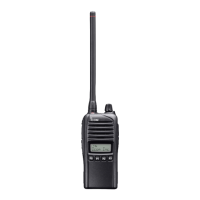10
3
BASIC OPERATION
3
■ Receiving and transmitting
CAUTION: Transmitting without an antenna may damage
the transceiver. Refer to page 1 for accessory attachments.
Receiving:
q Rotate [VOL] to turn ON the transceiver.
w Push [CH Up] or [CH Down] to select the conventional
system channel, in sequence.
e When receiving a call, adjust the audio output level to a
comfortable listening level.
NOTE: When a matched RX code signal is received,
audio from the microphone is automatically transmitted
for a specified time period.*
*
Depending on the presetting. Ask your dealer for details.
Transmitting:
Wait for the channel to become clear to avoid interference.
q Push [Call] when initiating a call from your side.
• Coded audio may be heard from the transceiver, then “ ” is
displayed.
• This operation may not be necessary depending on your
signaling system. Ask your dealer for details.
w While holding down [PTT], speak into the microphone at
a normal voice level.
e Release [PTT] to return to receive.
IMPORTANT: To maximize the readability of your signal:
1. Pause briefly after pushing [PTT].
2. Hold the microphone 5 to 10 cm (2 to 4 inches) from your
mouth, then speak into the microphone at a normal voice level.
D Transmitting notes
• Transmit inhibit function
The transceiver has several inhibit functions which restrict
transmission under the following conditions:
- The channel is in mute condition (‘Inaudible’ condition:
“
” is not displayed.)
- The channel is busy.
- Un-matched (or matched) CTCSS is received.
(Depending on the presetting.)
- The selected channel is a ‘receive only’ channel.
• Time-out timer
After continuous transmission for the preset time period, the
time-out timer is activated, causing the transceiver to stop
transmitting.
• Penalty timer
Once the time-out timer is activated, transmission is further
inhibited for a period determined by the penalty timer.
• PTTID call
The transceiver sends the ID code (DTMF or digital
ANI) automatically when [PTT] is pushed (beginning of
transmission) and released (end of transmission) depends on
the setting.

